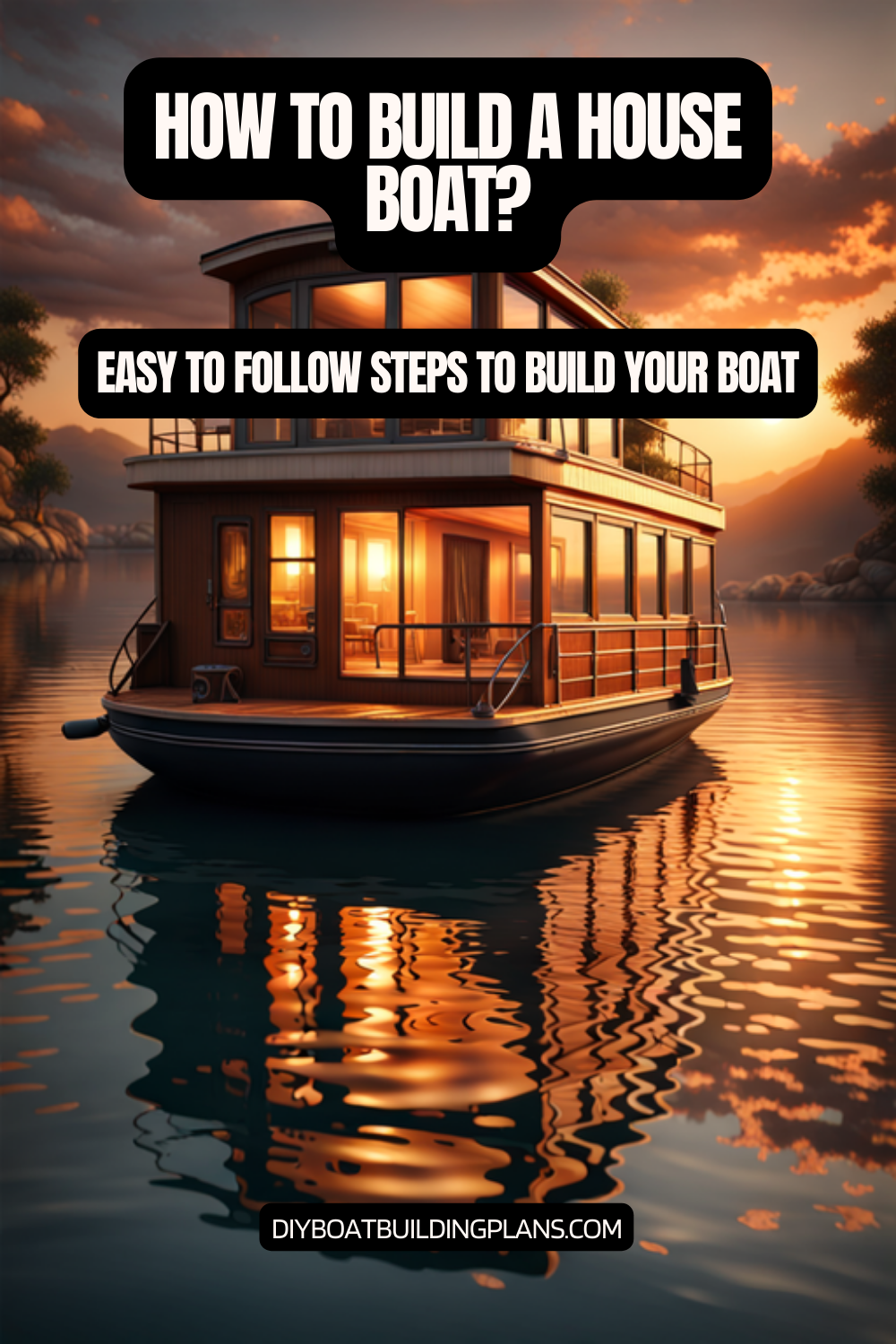Overview of How To Build a House Boat
When it comes to building a house boat, the first and most crucial step is to determine the intended use and lifestyle of the vessel. Are you looking to create a cozy weekend getaway, a full-time living space, or something in between? This decision will heavily influence the design and size of your house boat.
Next, consider the available space and budget. House boats can range significantly in size, from compact models to spacious multi-level structures. Carefully evaluate the space you have to work with, whether it’s a small backyard or a larger waterfront property, and ensure that the house boat you choose can be accommodated. Additionally, set a realistic budget that takes into account the materials, labor, and any necessary permits or regulations.
With the intended use and available resources in mind, it’s time to research different design options and their features. Explore various floor plans, layouts, and amenities to find the perfect balance of functionality and maneuverability. Consider factors such as the number of bedrooms, living areas, storage spaces, and outdoor decks. Carefully weigh the pros and cons of each design to ensure that it aligns with your needs and preferences.
Key Takeaways
- Choose a design and size that fits your needs and budget.
- Select materials that are durable and appropriate for marine environments.
- Construct the hull and deck with attention to detail and proper techniques.
- Install plumbing and electrical systems with safety and efficiency in mind.
- Outfit the interior living space with comfort and functionality in mind.

Selecting the Appropriate Materials
When it comes to building a house boat, the durability and weatherproofing of the materials used are of utmost importance. The house boat will be exposed to the elements, including water, wind, and sun, so it’s crucial to choose materials that can withstand these conditions.
Start by evaluating the specific requirements of your marine environment. Factors such as water salinity, temperature fluctuations, and exposure to UV rays can all impact the longevity of the materials. Research and compare the performance of different materials, such as marine-grade plywood, fiberglass, aluminum, and composite materials, to determine the best fit for your project.
In addition to durability, consider the weight and structural integrity of the materials. The house boat needs to be able to support its own weight, as well as the weight of its occupants and any additional equipment or furnishings. Carefully calculate the load-bearing capacity of the materials and ensure that they can provide the necessary strength and stability.
Finally, be mindful of local building codes and regulations. Certain materials may be required or prohibited, depending on the jurisdiction in which you’re building your house boat. Consult with local authorities and ensure that your material selections comply with all relevant laws and safety standards.
Constructing the Hull and Deck
The foundation of a house boat is the hull, which serves as the primary structure that keeps the vessel afloat. Begin by laying a solid foundation and framing the hull using the appropriate materials. This may involve constructing a wooden or metal frame, or using a pre-fabricated hull.
Once the hull is in place, it’s time to select the materials for the deck. The deck not only provides the living space but also plays a crucial role in the overall stability and aesthetics of the house boat. Consider factors such as slip-resistance, weather-resistance, and ease of maintenance when choosing the deck materials.
Ensuring proper waterproofing and sealing of the structure is paramount. The hull and deck must be meticulously sealed to prevent water intrusion and maintain the integrity of the house boat. This may involve the use of sealants, caulking, and specialized coatings to create a watertight barrier.
Incorporate design elements that enhance the stability and aesthetics of the house boat. This could include features such as a raised bow, a flat or curved deck, or integrated railings and guardrails. These design choices can not only improve the overall appearance of the house boat but also contribute to its stability and maneuverability on the water.
Installing the Plumbing and Electrical Systems
Designing the water supply and drainage systems for a house boat requires careful planning and attention to detail. The plumbing system must be able to provide a reliable and efficient water source, as well as effectively manage the wastewater. Consider factors such as water storage capacity, water pressure, and the placement of sinks, showers, and toilets to ensure a functional and user-friendly system.
Integrating the electrical wiring and power sources is another crucial aspect of building a house boat. Ensure that the electrical system is designed to meet the energy demands of the vessel, whether it’s powered by shore power, a generator, or a combination of both. Incorporate energy-efficient solutions, such as solar panels or wind turbines, to reduce the environmental impact and operating costs of the house boat.
Throughout the installation process, it’s essential to comply with all relevant safety standards and regulations. This may include adhering to specific electrical codes, implementing proper grounding and bonding, and ensuring the proper ventilation of any fuel-powered equipment. Prioritize the safety and well-being of the occupants by incorporating features such as emergency lighting, fire extinguishers, and carbon monoxide detectors.
Outfitting the Interior Living Space
| Step | Description |
|---|---|
| 1 | Choose a design and gather materials |
| 2 | Build the hull and deck |
| 3 | Install the electrical and plumbing systems |
| 4 | Construct the cabin and interior |
| 5 | Add finishing touches and decorations |
| 6 | Launch and enjoy your new house boat! |
Designing the layout and flow of the interior living space is a crucial step in creating a comfortable and functional house boat. Consider the intended use of the vessel and the needs of its occupants to determine the optimal arrangement of the living areas, sleeping quarters, and storage spaces.
When selecting furniture, fixtures, and appliances, it’s important to choose items that are specifically designed for marine environments. These products are typically more durable, compact, and water-resistant, ensuring they can withstand the unique challenges of living on the water.
Incorporate storage solutions and space-saving features to maximize the limited space available on a house boat. This may include built-in cabinetry, hidden storage compartments, and multi-functional furniture. Carefully plan the placement of these elements to maintain a sense of openness and flow throughout the interior.
Finally, focus on enhancing the overall comfort and livability of the interior. This may involve adding insulation, improving ventilation, and incorporating lighting and temperature control systems that create a cozy and inviting atmosphere. By paying attention to the details, you can transform your house boat into a true home on the water.
Ensuring Stability and Buoyancy
Maintaining the stability and buoyancy of a house boat is crucial for its safe and reliable operation. Begin by carefully calculating the weight distribution and center of gravity of the vessel. This will help you determine the appropriate placement of heavy items, such as water tanks and generators, to ensure the house boat remains balanced and stable.
Incorporate stabilizing features, such as keels, outriggers, or ballast systems, to enhance the vessel’s ability to withstand waves and weather conditions. These features help to counteract the effects of wind, waves, and currents, providing a more stable and comfortable ride for the occupants.
Test the stability and buoyancy of the house boat before launching it into the water. This may involve conducting stability tests, measuring the draft, and ensuring the vessel can support the intended load without compromising its seaworthiness. Make any necessary adjustments to the design or weight distribution to ensure the house boat’s ability to safely navigate the waterways.
Navigational and Safety Considerations
Equipping your house boat with the necessary navigation and communication devices is essential for safe and responsible operation. This may include items such as GPS systems, depth finders, radios, and emergency beacons. Ensure that these devices are properly installed and integrated into the overall system, allowing you to monitor your position, communicate with other vessels, and respond to any emergencies that may arise.
Implementing comprehensive safety features and emergency response systems is also a critical aspect of house boat construction. This may include fire extinguishers, life jackets, emergency ladders, and first-aid kits. Develop a detailed emergency preparedness plan that covers scenarios such as man overboard, engine failure, or severe weather conditions.
Familiarize yourself with the local waterway regulations and guidelines that apply to your house boat. These may include speed limits, navigation rules, and any restrictions on the size or type of vessels allowed in certain areas. Ensure that your house boat is in compliance with all relevant laws and regulations to avoid any legal issues or safety concerns.
Launching and Mooring the House Boat
Selecting an appropriate launch site and mooring location is crucial for the successful and safe operation of your house boat. Consider factors such as water depth, accessibility, and any local regulations or restrictions that may apply. Ensure that the launch site can accommodate the size and weight of your vessel, and that the mooring location provides adequate protection from the elements and other watercraft.
When it’s time to launch the house boat, carefully plan the loading and transportation process. This may involve the use of a trailer, a boat ramp, or a crane, depending on the size and weight of the vessel. Ensure that the house boat is properly secured during the transportation and launch to prevent any damage or accidents.
Once the house boat is in the water, focus on securing it to the mooring and maintaining its position. This may involve the use of anchors, lines, or even a mooring buoy. Regularly check the mooring system and make any necessary adjustments to ensure the house boat remains stable and secure, even in changing weather conditions.
If you plan to relocate your house boat, carefully consider the logistics involved. This may include arranging for transportation, obtaining any necessary permits or permissions, and ensuring the vessel is properly prepared for the move. Develop a comprehensive plan to ensure a smooth and safe relocation process.
Maintenance and Upkeep Tips
Maintaining the long-term durability and functionality of your house boat requires a proactive and consistent approach to maintenance and upkeep. Begin by developing a regular maintenance schedule and checklist, covering tasks such as cleaning, inspecting, and servicing the various components of the vessel.
Regularly address any necessary repairs or replacements in a timely manner. This may include addressing issues with the hull, deck, plumbing, or electrical systems. Ignoring these problems can lead to more significant and costly issues down the line, so it’s essential to stay on top of any maintenance needs.
Protecting the house boat from environmental factors and weathering is also crucial for preserving its condition. This may involve applying protective coatings, covering the vessel when not in use, and storing it in a sheltered location during the off-season. Regularly inspect the house boat for signs of wear and tear, and take proactive steps to mitigate any potential issues.
By following a comprehensive maintenance and upkeep plan, you can ensure the long-term durability and functionality of your house boat. This will not only extend the life of your investment but also provide you with a safe and enjoyable living experience on the water for years to come.

Conclusion – How To Build a House Boat
Creating a houseboat can be a fulfilling and unique endeavor, offering the chance to live on the water, surrounded by scenic beauty, and tailored to your personal preferences. However, it’s essential to acknowledge that building a houseboat is a complex, time-consuming, and challenging undertaking, demanding a blend of construction skills, patience, and financial resources. Moreover, you must adhere to legal and safety requirements when owning and operating a houseboat.
Download over 500 Boat Plans. Click on the link below.
-->Click Here<--
In this article, we have provided a comprehensive guide for building your dream houseboat, beginning with understanding the concept and the motivation behind building one. We’ve covered critical aspects like experience and skill levels, tools and equipment, the intended purpose and features of your houseboat, budget and time constraints, and design considerations. Moreover, we’ve emphasized the importance of understanding the legal and safety aspects, along with the significance of materials, construction techniques, and design principles.
Planning and designing your houseboat is a crucial stage, involving researching different houseboat types, identifying your project’s purpose and specifications, and understanding the relevant rules and regulations. You must also gather information on materials, construction techniques, and design principles to make informed decisions. Creating detailed sketches, diagrams, and blueprints is vital in this process, and computer-aided design (CAD) software can be a valuable tool to assist you in visualizing your project with precision and accuracy.
The final steps include creating a comprehensive material list, sourcing high-quality materials, acquiring the necessary tools and equipment, and preparing your workspace for construction. These steps are essential for the successful execution of your houseboat project.
In summary, building a houseboat is an exciting journey that offers immense customization and cost-effectiveness. It provides a deep sense of accomplishment and satisfaction as you turn your dream home on the water into reality. However, it’s not a task for the faint of heart, and careful planning, skill acquisition, and adherence to regulations are fundamental to its success. By following the guidelines in this article, you will be well-prepared to embark on your houseboat building adventure, knowing the challenges and rewards that await you. Best of luck with your houseboat project!
FAQs – How To Build a House Boat
What is a house boat?
A house boat is a type of boat that is designed to be used primarily as a residence. It is typically equipped with all the amenities of a traditional home, including a kitchen, bathroom, and sleeping quarters.
What are the benefits of building a house boat?
Building a house boat can be a great way to enjoy the water and live a unique lifestyle. It can also be a more affordable option than buying a traditional home, and it allows for greater flexibility in terms of location.
What materials are typically used to build a house boat?
House boats can be built using a variety of materials, including wood, fiberglass, and aluminum. The choice of materials will depend on factors such as the size of the boat, the intended use, and the builder’s preferences.
What are the basic steps involved in building a house boat?
The basic steps involved in building a house boat include designing the boat, selecting materials, constructing the hull, building the superstructure, installing the electrical and plumbing systems, and outfitting the boat with furniture and appliances.
Do I need any special skills or tools to build a house boat?
Building a house boat can be a complex project that requires a range of skills and tools. It is recommended that builders have experience with woodworking, electrical and plumbing systems, and boat building. Specialized tools such as saws, drills, and welding equipment may also be required.
How long does it typically take to build a house boat?
The time it takes to build a house boat will depend on a variety of factors, including the size of the boat, the complexity of the design, and the builder’s experience. It can take anywhere from several months to several years to complete a house boat project.



